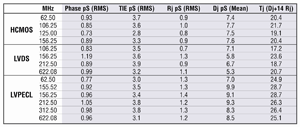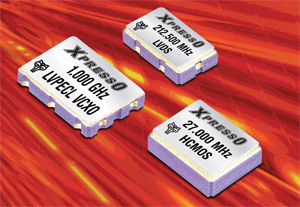Evolving oscillator technology answers frequency control needs
Improving performance, price, and delivery time satisfy both designers and buyers
BY ROGER BURNS
Fox Electronics
Fort Myers, FL
http://www.foxonline.com
Higher frequencies and low jitter are being prominently featured on the list of oscillator criteria for designers. In addition, low cost and quick delivery are top criteria of buyers. Having timely oscillators options that can deliver the highest desired performance while minimally compensating design steps is a key to cost-effective solutions. Fortunately, in the ongoing battle to push the limits of technology and component costs, oscillator manufacturers continue to close the gap between high-level performance and cost-effective purchasing.
Several recent advancements in oscillator technology offer designers and manufacturers new options in applications such as telecommunications and data networks as well as consumer products. These developments include configurable-oscillator technology, which make the delivery of oscillators and voltage-controlled crystal oscillators (VCXOs) more timely and affordable than ever before.
Configurable technology cuts conventional oscillator costs and lead times
The introduction of the latest configurable-oscillator technology offers technical and business advantages, in terms of performance and delivery times, across a wide spectrum of oscillator uses. But it is the ability to deliver those advantages at frequencies of 750 kHz to 1.35 GHz with low-jitter (see Fig. 1 ) and phase noise characteristics comparable to conventional custom oscillators that make this technology particularly attractive for subscriber applications such as wireless WiMAX or WiBRO data networks. This technology can also be the clock source for 10G Ethernet, optical networks, FPGAs (field-programmable gate arrays), ADSL (asymmetric digital subscriber line), and many other applications.

Fig. 1. New technologies in jitter and noise characteristics make configurable oscillators comparable to or better than those of fixed-frequency oscillators.
Until the evolution of configurable-oscillator technology, shortening the long lead times typically associated with custom-made conventional oscillators of any frequency usually involved compromising some aspect of performance. While it is possible to use multipliers to tune a stock fixed-frequency oscillator to a higher frequency for a specific application, that approach tends to magnify noise problems proportionally. Programmable oscillators (see Fig. 2 ), developed in the early 1990s as a solution for quicker oscillator turnaround, also offer an alternative for shortened lead times. Unfortunately, their noise characteristics often limit them to low-volume production runs where noise is not a problem or to prototype applications where noise problems can be rectified by ordering conventional custom oscillators for the actual production run.

Fig. 2. Programmable oscillators generate any desired frequency with the use of a conventional oscillator crystal run through a programmable PLL, post divider, output multiplexer, and output buffer.
New approach yields new performance results
Instead of using a “one-solution-fits-all” approach like programmable oscillators, the new configurable-oscillator technology uses a modular building-block architecture to provide the desired frequency without compounding the noise in the performance of the finished product.
Like a programmable oscillator, a configurable oscillator starts out with a conventional oscillator crystal blank that runs the output through a series of functions. But instead of using a conventional integer phase-locked loop (PLL) that covers a wide frequency range, it uses one of several fractional-N PLLs chosen based on the desired frequency for the final application (see Fig. 3 ). This fractional-N PLL doesn’t divide the reference frequency and therefore, eliminates one of the noise problems associated with programmable oscillators.

Fig. 3. New configurable-oscillator technology yields custom-frequency oscillators with performance characteristics similar to conventional oscillators by incorporating modular blocks to lessen noise problems
A problem introduced by the fractional-N PLL, however, is that irregular divisors create spurs as noise elements. To compensate for this, the configurable-oscillator design adds a third-order Delta Sigma Modulator (DSM) block to lower the overall amplitude of the spurs by spreading them out to different spots over time. This creates a signal that is the “mirror image” of the noise in the oscillator, effectively canceling it out. (A familiar everyday example of this principle at work would be the performance of “noise-canceling” headphones used by music aficionados.)
The final step in the configurable-oscillator process adds one of three types of output buffers, depending on the needs of the application. HCMOS is the most popular, and is used for the majority of lower-frequency applications. However, LVPECL and LVDS outputs are available to satisfy higher frequency applications.
By using common components in such a modular approach, it is possible to choose which crystal blank, fractional-N PLL, DSM, and output buffer are needed to configure an affordable oscillator package that satisfies the frequency, noise requirements, and output type needed by the application. The available combinations create HCMOS oscillators and VCXOs from 750 kHz to 250 MHz, LVPECL oscillators and VCXOs from 1.00 MHz to 1.35 GHz, as well as LVDS oscillators and VCXOs from 1.00 MHz to 1.35 GHz.
In each case, the result is a functional oscillator featuring the quick delivery time of a programmable oscillator, yet operating at a custom-specified frequency with low-jitter and noise characteristics similar to those of conventional oscillators. Application-specific integrated circuits (ASICs) used in the various configurable-oscillator modules provide precise performance and cost-effective production. In addition, the small die sizes for oscillator circuitry combined with the use of common-frequency crystal blanks, achieve the desired results at price points that are even lower than those of conventional oscillators.
Another advantage of this new technology is that these good things do indeed come in small packages. High-frequency configurable oscillators and VCXOs are available in package sizes down to 5.0 x 3.2 mm.

Fig. 4. The above oscillators provide custom frequencies from 1.0 MHz to 1.1 GHz.
Technical improvements deliver business benefits, too
In addition to its desirable performance characteristics, manufacturing costs and lead times of the new configurable-oscillator technology make the oscillators an attractive alternative for applications with volumes too low to benefit from any economy of scale in custom-manufactured conventional oscillators. This is particularly true for specialized applications where order volumes might be as low as 1,000 or 2,000 units, as opposed to consumer electronics applications where order volumes are often in the hundreds of thousands or greater.
But even more important, the efficiencies and economies of scale in using common modular components make configurable oscillators a quicker and more cost-effective solution than conventional oscillators across the board. They deliver low jitter and phase noise characteristics comparable to those of fixed-frequency oscillators, at a lower cost. Since a configurable oscillator can be produced to custom specifications in just a fraction of the time of a conventional oscillator, it cuts down typical delivery times from 8 or 10 weeks to less than 2 weeks.
Keeping the leading edge moving forward
Whether oscillators are used at their specific frequency, or tuned to higher frequencies through the use of multipliers or PPLs, the need for accurate, affordable, low-noise, and stable performance never changes. Staying aware of the latest options enables system designers to develop more precise and more competitive product solutions. The new configurable oscillators offer significant promise in terms of performance, price, and product delivery to satisfy both the technical and business needs of designers and buyers.
Advertisement
Learn more about Fox Electronics





